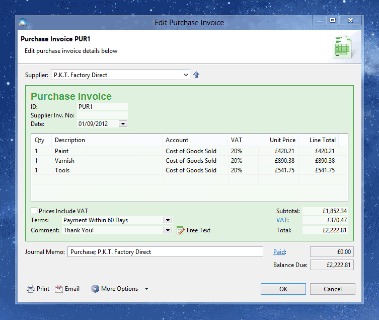How to Control Accounts Receivable Effectively

She holds a Masters Degree in Professional Accounting from the University of New South Wales. Her areas of expertise include accounting system and enterprise resource planning implementations, as well as accounting business process improvement and workflow design. Jami has collaborated with clients large and small in the technology, financial, and post-secondary fields.
A bookkeeping and accounting system needs internal control procedures for accounts receivable in order to minimize the risk of fraud, error and loss. When customers don’t pay your invoices on time, this can strain your company’s finances. After all, you still have payroll, insurance, and other bills that you must pay on time. When a customer pays late, a business owner may have to pull funds from other sources to pay the company’s bills on time. This may even prevent a company from being able to make purchases to satisfy different customers’ orders.
For most of these methods, businesses will need a merchant account and in many cases a payment processor. You may also choose to use accounting software like FreshBooks that integrates with payment processors so customers have an easy way to pay their invoices online. Offering several easily accessible payment options can help reduce the likelihood of late current ratio calculator working capital ratio or unpaid invoices. The goal of effective accounts receivable management is to optimize your billing, payments, and collections process to minimize the time it takes to get paid and eliminate the risk of bad debt. The purpose of accounts receivable internal controls is to ensure that sales invoices are properly recorded and that customers pay promptly in accordance with the agreed terms of business.
Days Sales Outstanding

But if some of them pay late or not at all, they might be hurting your business. Late payments from customers are one of the top reasons why companies get into cash flow or liquidity problems. If you use bookkeeping software, it can be easy to see if they still owe money. If your software allows you to put limits in place, this can bookkeeping journals also prevent a customer who has an unpaid bill to order again without someone’s review. In some cases, it may be the owner of the company that is sending out customer invoices.
Your business can stay on top of collecting payments, while keeping communications tailored to each customer, without any wasted time. That is, they deliver the goods and services immediately, send an invoice, then get paid a few weeks later. Businesses keep track of all the money their customers owe them using an account in their books called accounts receivable. An accounts receivable aging report shows which customers owe money and how old their invoices are. It’s a good practice to deposit payments into your bank account as soon as possible to prevent them from being lost or misplaced. It also helps to ensure that the customer’s funds will be available.
Verify Customer Balances
Accounts Receivable is the amount a business holds in ongoing customer debts. An efficient Accounts Receivable process is key to ensuring good cash flow, maintaining positive customer relations, and collecting payments. Accounts Receivable Open, or AR Open, measures how many ongoing Accounts Receivable a business has in a given period. Closing Accounts Receivable translates to more payments being resolved; having Accounts Receivable remain open indicates ongoing disputes, unpaid invoices, or attempts to resolve bad debt. As your business grows, the volume of Accounts Receivable payments that you process will increase. Establish a system that can grow seamlessly alongside your business.
Learn about accounts receivables automation
- It’s best to send a gentle reminder for the earliest contact and then include more formal documentation if the customer continues to ignore payment.
- A customer that detects sloppiness or uncertainty in your approach will take advantage of it and turn it into an excuse not to pay.
- And for really new businesses, credit checks won’t show anything and don’t provide value at all.
- Automating your invoice process can help guarantee prompt and accurate invoicing.
- This helps to ensure that a customer does not exceed their limit when an order is placed.
Simply getting on the phone with a client and reminding them about unpaid invoices can often be enough to get them to pay. Sending email reminders at regular intervals—say, after 15, 30, 45, and 60 days—can also help jog your customers’ memory. The accounts receivable turnover ratio is a simple financial calculation that shows you how fast your customers are at paying their bills. If you do business long enough, you’ll eventually come across clients who pay late, or not at all. When a client doesn’t pay and we can’t collect their receivables, we call that a bad debt. Recording payments regularly keeps your accounts receivable aging reports current.
These tools and data can inform how you standardize invoice creation, maintain and report receivable accounts, and how you collect and record invoice payments. Sometimes it invoice online or on the go might be the right move for your company to outsource AR but ask yourself if you are doing it for the right reasons. If you are outsourcing only because of the operations of AR then this is a mistake. Instead, opt for using specialized AR software that will keep this process internal and will do most of the heavy lifting of the collection process thanks to automation. Keeping AR internally ensures you are adding value to your customer relations, and you are sending invoices and reminders at appropriate times and to the right points of contact. External AR management simply does not have the insights that you have in your own business and will likely fail at providing the right service and keeping good relations with your customers.
To begin the ordering and Accounts Receivable process, a customer will place an order that needs to be approved by the business. Once the company receives and approves this order, it generates a sales order which includes details about quantity, price, payment date, and any other relevant terms of sale. If both parties approve the sales order, it becomes a binding agreement. The alternative to setting up your own processes and software in-house is to outsource AR management to an accounts receivable management service. If you are not getting paid and it is not a technical issue, chances are that there might be a larger underlying issue in your process. This is when you can leverage your sales and success teams that have direct contact with customers to help identify the root cause and find a solution.
It also indicates that your customer credit assessment is effective since you have a high ratio of paid invoices to total invoices. Invoicing is an essential step in your Accounts Receivable process flow. It sets in motion the payment process and outlines payment terms, encouraging customers to promptly pay their debts.
Filled Under : Bookkeeping
